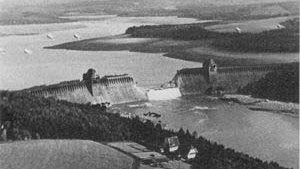| In early 1943, a ultra secret idea was hatched by the British to destroy the dams supplying water and power to the industrial heartland of the German war effort, the Ruhr Valley.The dams were of course heavily defended with anti-aircraft cannon on the hills and all strategic points in and around the dams along with submarine nets to prevent torpedo attacks.A British scientist and inventor came up with a unique solution for attacking the dams using a drum shaped bouncing bomb. This was designed to hit the water behind the dam at a precise speed and very low altitude, and at a precise distance from the dams. The bomb, codenamed “upkeep” would be spun backward at high rpm before release. This would slow it somewhat once it hit the water in order to trail behind the plane and not bounce back up into it. The spin would also carry the bomb further while it skipped over the submarine nets, hit the dam and the roll would keep it close to the dam face as it sank to explode like a depth charge.
To carry out this unheard of and nearly impossible task, a special select force of Commonwealth aircrew was assembled, with Canadians figuring prominently, to form the special purpose X-Squadron. later 617 For weeks they practiced extremely low-level night flying with the huge bombers, Then on May 16 at 9:28 pm the first of the Lancs struggled off the grass strip with its single four ton bomb.the others following. The small elite force of 19 bombers headed out towards Germany and the Mohne, Eder, and Sorpe dams.  As they began closing in on the targets, they were flying extremely low. In fact to avoid flak which had shot down another bomber, AJ-H “Harry” actually touched the sea on route and the bomb was ripped out. Now useless, the slightly damaged plane struggled home. Two more flew into power lines on the way in overland. Others carried on through the flak and fighter attacks. The squadron, all in their early twenties, were led by 24 year-old Wing Cmdr Guy Gibson. With astounding courage the surviving pilots and crew held their craft steady at a mere 60 feet above the water at exactly the 220 mph* necessary and then at the precise moment which had been calculated, the spinning bombs were released. It took five runs to breach the Mohne, three planes attacked and breached the Eder. The second wave was to attack the Sorpe, a different type of dam and much harder to breach This time there would be no spinning or bouncing of the nicknamed “upkeep” bomb, which would be dropped more like a conventional bomb Of the second wave, four planes were either shot down, or heading home as was the case for AJ-H. One of the three still living veterans of the Dambusters, George “Johnny” Johnson** was the bomb aimer on the lone plane to strike the Sorpe. The pilot had to dive down one side of the valley fly about 30 feet over the dam, then pull up steeply to avoid the other side. The run was made nine times before Johnny was satisfied on the tenth run of his target. The bomb was released and exploded against the earthen dam causing much damage but no complete breach. In the end 8 planes and 56 men, 13 of them Canadians, did not make it back. Some 1600 civilians were drowned by the flood waters of the breached dams. This incredible effort although not a complete success, nevertheless achieved a good measure of tactical success by shutting down a number of factories, hampering supply routes, and obliging more German forces to be stationed around the sites. It was however a huge morale boost for Allied forces. The bravery and skill of the aircrew cannot be underestimated. *different sites report differing airspeeds for the necessary precision. **Fred Sutherland of Alberta Canada is another of the three remaining veterans, the third is Les Munro of New Zealand. CBC story and interview with survivor Fred Sutherland (note since the Mail Online was published, there was a change and the flypast was carried out..see video here… BBC)
|

Practice trials with the four ton barrel-shaped "upkeep" bouncing bomb, launced from specially modified Lancasters
Photo Credit: Imperial War Museum






For reasons beyond our control, and for an undetermined period of time, our comment section is now closed. However, our social networks remain open to your contributions.